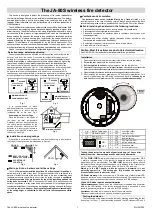
10 - ENG PN MN234 G | User Manual
Liberator
Cleaning Standard
WARNING: CLEAN ONLY AFTER THE UNIT
IS EMPTY.
• Clean using a solution of mild dish washing
detergent and water.
• Apply cleaning solution directly to a lint-free
cloth. Approved cleaners include HydroPure
and HydroKlean. Do not spray cleaners
directly on the Liberator.
• Wipe the outside surface with the lint-free
cloth until the outside surface is clean.
Caution: Do not use high temperature
and high pressure washing equipment
to clean these units.
• Do not get cleaner on any internal compo-
nents or valves.
• Allow the unit to dry thoroughly before using.
Note: Note to health care provider – for reprocessing
procedures, see applicable service manual.
Disposal
Always return Liberator, including all components,
to your homecare provider for proper disposal. You
can also contact your local city or town offices for
instructions on proper disposal of the battery.
WEEE and RoHS
This symbol is to remind the equipment owners to
return it to a recycling facility at the end of its life,
per Waste Electrical and Electronic Equip-
ment (WEEE) Directive.
Our products will comply with the restriction of
Hazardous Substances (RoHS) directive. They will
not contain more than trace amounts of lead or
other hazardous material content.
Transport and Storage
The device should be stored in the upright position,
and be well ventilated. Do not allow the device to
lie on its side. Humidity up to 95% noncondensing.
Temperatures range from -40°F to 158°F (-40°C to
70°C).
Operating temperature ranges from 14°F to 104°F
(10°C to 40°C). Relative humidity range from 30%
to 75% noncondensing.
Note: The atmospheric pressure range is 700 hPa to
1060 hPa (elevation of 10,000 Ft. to -1,000 Ft.).
Accessories
Cannula
Position with prongs facing upward in nose and loop over ears.
Slide adjuster under chin until comfortable.
Condensate Bottle
Roller Base
NOTE: Ensure the proper size roller base is used
with the Liberator.
NOTE: Only use roller base on flat surfaces.
Note: To Equipment Provider: The following oxygen
administration accessories are recommended for use
with the HELiOS:
• Nasal Cannula: CAIRE Part Number 6-778057-00
• Firebreak: CAIRE Part Number 21126636
A firebreak is recommended for use with any can-
nula.
• CAIRE offers a firebreak intended to be used in
conjunction with the oxygen reservoir. The firebreak
is a thermal fuse to stop the flow of gas in the event
that the downstream cannula or oxygen tubing is
ignited and burns to the firebreak. It is placed in-line
with the nasal cannula or oxygen tubing between
the patient and the oxygen outlet of the HELiOS.
For proper use of the firebreak, always refer to the
manufacturer’s instructions (included with each
firebreak kit).
• For any additional recommended accessories,
please see the Accessories Catalog (PN MLLOX0010)
available on www.caireinc.com.


































